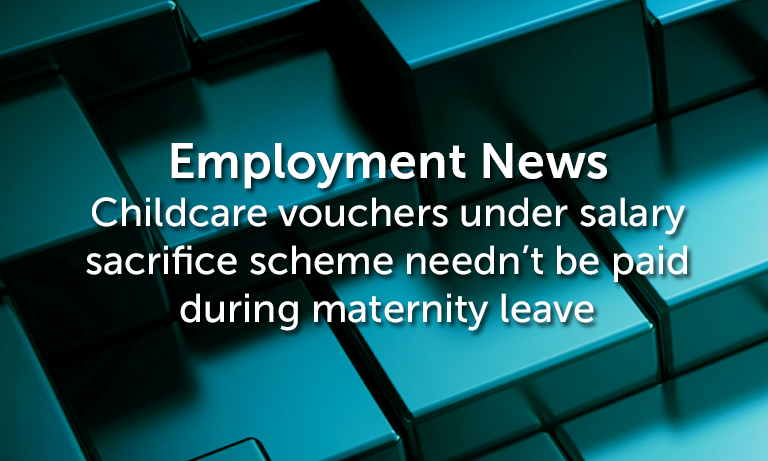 There are currently two ways in which an employee can access child care vouchers. Both depend on the employer voluntarily operating a scheme and the employee opting into this
There are currently two ways in which an employee can access child care vouchers. Both depend on the employer voluntarily operating a scheme and the employee opting into thisA recent judgment means that it will be lawful for an employer to require the suspension of membership of a childcare voucher salary sacrifice scheme while an employee is on maternity leave.
The Employment Appeals Tribunal (EAT) has just ruled (Peninsula Business Services v Donaldson) that childcare vouchers provided under a salary sacrifice scheme are part of the employee’s “remuneration”. They therefore do not have to be provided during maternity leave.
There are currently two ways in which an employee can access child care vouchers. Both depend on the employer voluntarily operating a scheme and the employee opting into this.
• Some rare and generous employers will simply give their employees the vouchers on top of their normal salary.
• More commonly, employers will ask their employees to do a “salary sacrifice” whereby they give up a proportion of their pay, and instead receive child care vouchers.
As no tax or National Insurance needs to be paid on the value of the child-care vouchers, this can be financially advantageous for employees (and employers).
Whilst she’s on ordinary or additional maternity leave, an employee is entitled to the benefit of all the terms and conditions of her employment that would’ve applied, had she not been absent; the exception to this rule is remuneration (which is usually replaced by statutory maternity pay or maternity allowance).
Whether childcare vouchers provided via salary sacrifice schemes should be treated as a “noncash benefit”, which should continue to be provided during maternity leave, or as “remuneration” (“sums payable to the employee by way of wages or salary”), which would fall within the exception, has been a point of contention for some time.
2008 HMRC guidance (the HMRC Guidance) suggested that childcare vouchers were non-cash benefits, even if they’d been provided by way of salary sacrifice. Employers couldn’t therefore compel employees to opt out of receiving such vouchers during maternity leave which meant that this was a cost to an employer whilst an employee was on maternity leave.
The facts
Peninsula Business Services (Peninsula) employed Ms Donaldson. Peninsula gave its employees the option of a reduced salary in return for tax-saving childcare vouchers (provided by a third party childcare voucher company) via a salary sacrifice scheme (the Scheme).
Employees had to agree to suspend their membership of the Scheme during certain types of leave (including maternity and paternity leave, and periods of sick leave when they only received statutory sick pay) before they could participate in it.
Mrs Donaldson looked at joining the Scheme. She was pregnant. She wouldn’t agree to the prerequisite so couldn’t join the Scheme. She brought claims for detriment and for discrimination. The Employment Tribunal agreed with her. It held that childcare vouchers were a non-cash benefit.
Peninsula had subjected Ms Donaldson to unfavourable treatment and a detriment by imposing the term that she couldn’t be a member of the Scheme during maternity leave. In its appeal, Peninsula argued, amongst other things, that the HMRC Guidance had no legal basis and was incorrect: childcare vouchers provided under a salary sacrifice scheme were remuneration.
The vouchers had to be paid for and money had to be earned for the tax savings to operate. If the employee received SMP only, they had no “salary” from which a sacrifice could be made.
The EAT allowed Peninsula’s appeal, dismissing all of Ms Donaldson’s claims. It found that the way that the Scheme worked was to “divert” (rather than “sacrifice”) some of the employee’s salary so that rather than being paid to Ms Donaldson directly, it was used to buy vouchers.
Tentative conclusions
If child care vouchers under a salary sacrifice were simply diverted salary – it’d be easy to see why they should be considered part of the employee’s remuneration. In truth though, it’s more complicated than that. In signing up to such a scheme Ms Donaldson would have had to give up her right to a higher “notional” salary.
She couldn’t have then relied on this for e.g. the calculation of her SMP. When you look at it in this light, you can see why Ms Donaldson found herself between a rock and a hard place, and why the word “sacrifice” in the phrase “salary sacrifice” might not be such a misnomer.
On the other hand, you can see the policy reasons behind the EAT’s decision. If the employer had to bear the additional cost of continuing to provide the vouchers during maternity leave (as well as providing statutory maternity pay, where applicable), this might discourage them from offering the vouchers in the first place.
The favourable tax treatment of childcare vouchers through salary sacrifice aims to enable and encourage those with young children to remain in or return to the workplace. If the (existing) scheme is to work, it needs employers to participate. The EAT was itself cautious that it may not have had sight of all relevant legislation in reaching its decision and therefore expressed its conclusions: “somewhat tentatively”.
What should employers do now?
• Look carefully at how your scheme operates.
• If you pay your employees child care vouchers via a salary sacrifice scheme, then as things stand now, you may now lawfully include a condition in that scheme whereby you suspend the scheme during maternity leave. The EAT was tentative in reaching its conclusions though, so we’d suggest that you behave similarly- be mindful that this decision may be challenged in the future.
• Childcare vouchers that are provided on top of salary (rather than as part of/diverted salary) are not remuneration, so you shouldn’t be suspending payment of these during maternity leave.
• Childcare voucher schemes will be closed to new entrants anyway from April 2018. The Government confirmed in its budget that it will launch the new tax-free childcare scheme early next year (which will operate directly between parents and the Government).
By Simon Whitehead, Partner at HRC Law
Join Over 40,000 Recruiters. Get our latest articles weekly, all FREE – SEND ME ARTICLES
Recruiters love this COMPLETE set of Accredited Recruitment & HR Training – View Training Brochure








